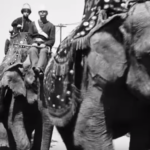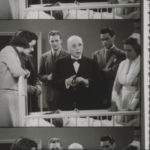Apu Trilogy: Revived from Flames

n
Even at the time of Satjajit Ray’s death in 1992, aged 70, the films of the astonishing “Apu Trilogy” were in sad shape, to their maker’s great regret.
The original prints had been so badly damaged that they had risked being thrown out.
Their resurrection, now, in a 4K digital restoration, is a remarkable event in film preservation.
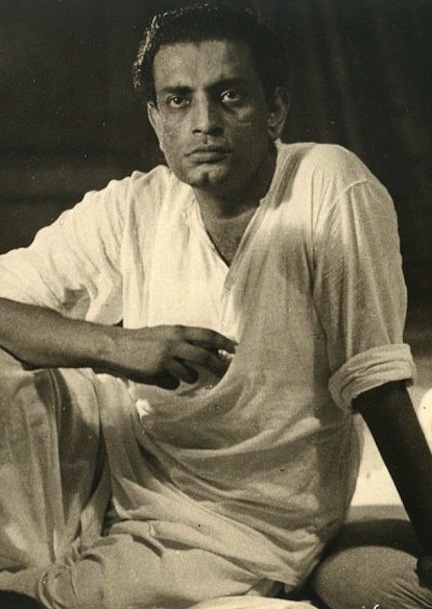
Satyajit Ray in 1955 during the recording of Ravi Shankar’s score for Pather Panchali
Ray, inspired by the poetic, naturalistic films of Italian neorealism, made his three-film masterpiece in the 1950s, based on two novels by Bibhutibhusan Banerjee. Pather Panchali (Song of the Little Road, the first of his 28 feature films, completed in 1955 after three years of work), Aparajito (The Unvanquished, 1956), and Apur Sansar (The World of Apu, 1959) depicted the life of an initially young boy in a rural Bengali family who was, by the end of the trilogy, a worldly student aspiring to a life in writing.
That echoed Ray’s own aspirations. In 1950, he had moved to London with his wife to work at an advertising agency, and there immersed himself in Western film. He had been particularly taken with Vittorio De Sica’s Bicycle Thieves, and the works of Jean Renoir, and those inspired him to write a treatment for Pather Panchali, and set about planning to film it. Like De Sica, he filmed his masterwork with nonprofessional actors, in outdoor locations, and with very little money.
Ray’s films took art-house cinemas and festivals in New York and other Western capitals by storm, winning many awards. Their completion was testimony not only to the ingenuity of Ray, and his broad skills in design, art direction, and dramatic range, but also to his love of the cinema of De Sica, Renoir, and their contemporaries, and of earlier Soviet cinema by the likes of Sergei Eisenstein and Vsevolod Pudovkin. His vision and ambition also owed much to his education at Santiniketan, the rural university founded by the great Indian polymath, Rabindranath Tagore.
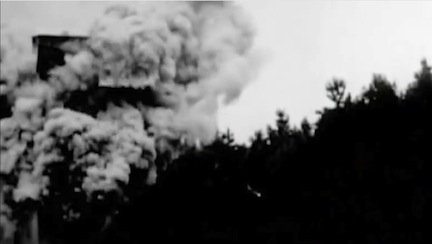
The Henderson Lab fire, 1993
In 1992, when the Academy of Motion Picture Arts and Sciences decided to make a lifetime-achievement award to Ray, the dearth of decent prints obstructed preparation of a tribute to him. That led a group of film organizations to launch a broad restoration of his work; but in July 1993, just as the effort was gearing up, an intense fire sparked by an explosion of nitrate film stock at Henderson’s Film Laboratories, in South London, immolated several vaults and severely damaged or even completely destroyed several Ray prints. The negatives of the Apu Trilogy were harmed so badly that technicians feared they would forever be unusable.
Still, with great foresight, the Academy Film Archive took possession of the damaged film and placed it in its storage vaults.
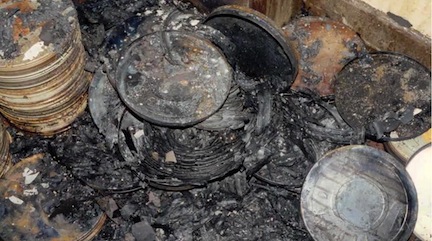
Aftermath of the fire
That would prove particularly fortuitous. In 2013, the Criterion Collection, an American video-distribution company that specializes in issuing classic and contemporary films, was looking for material for a restoration of the trilogy, and learned of the salvaged negatives. And it turned out that, thanks to technological capabilities that had by then come available, a good deal of the material could be used, although it took a mighty effort.
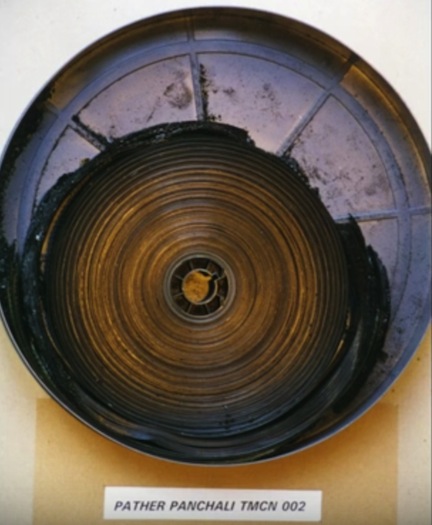
Damaged “Pather Panchali” negative
The process is illustrated in a stunning trailer for a Criterion Collection DVD and Blu-ray release, which has come a few months after the presentation of the trilogy on the international film-festival circuit. The three films are available individually or in a collector’s set that includes the 4K digital restorations of the three films, with uncompressed monaural soundtracks on the Blu-rays. They are also available online, through Criterion. Among many extras are a 1958 audio recording of Ray reading his essay “A Long Time on the Little Road,” a video essay by Ray biographer Andrew Robinson, and excerpts “Apur Saa 2003 documentary film, The Song of the Little Road, which features composer Ravi Shankar, who created the musical accompaniment for the trilogy.
The Academy has made a short tribute film, An Act of Faith: Saving “The Apu Trilogy,” in which Criterion president Peter Becker and technical director Lee Kline describe the restoration. Becker says: “The Apu Trilogy was in a sort of special place not only in [Ray’s] career, because it was the start of his career and launched him on the international scene, but also because the films themselves were in such lamentable condition.”
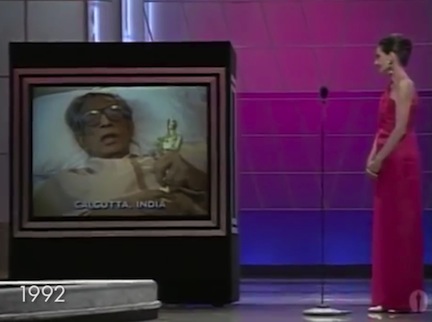
Ray accepts his honorary Oscar
Josef Lindner, preservation officer with the Academy Archive, says in An Act of Faith that “when we had the opportunity to do this digital restoration, with Criterion, that started us thinking, ‘Is there anything left?'” Could they go back and make use of the prints that had been placed in the Academy’s vaults after the Henderson Labs fire, and that had sat untouched there for 20 years?
It turned out that while the condition of some of the film was “horrific,” other sections were salvageable. Says Lee Kline, technical director at The Criterion Collection: “The first can that we opened should have made us just close the cans and say ‘We can’t use them’ because the film literally looked like it was on fire.” Charred, melted, fused, scratched… “You really couldn’t pick it up without it literally falling apart in your hands, “ he says. It was everything restorationists blanch to see; but that also solicited their most imaginative and technically proficient response.
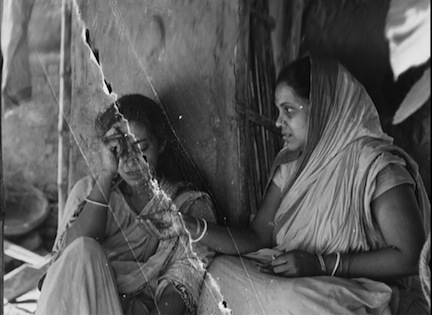
Even before the Hamilton Labs fire, the original negatives and prints of the Apu Trilogy were in bad shape
Becker says Criterion and the Academy took out pieces that were completely burned, and then entrusted to L’Immagine Ritrovata, at the Cineteca di Bologna, in Italy, the task of slowly, laboriously rehydrating the film using a solution of glycerol, acetone, and water. That made the material less brittle, and less likely to fracture and disintegrate. Over the course of thousands of hours, technicians at L’Immagine Ritrovata worked on the film. They scanned the film, sprocketless, because so many sprockets had been damaged or completely burned off the edges of the film stock; they used pin-registered wet-gate scanning. Along the way, they repaired the film by, for example, removing melted tape and glue, and rebuilding extensively the many damaged or destroyed perforation holes. They then digitally recreated the original in 4K resolution. In essence, Criterion and Archive technicians had to piece the original films back together, frame by frame, for the digital restoration.
In the process, 40 percent of the original negative of the first film of the trilogy, and 60 percent of the second, was salvaged. The Academy and Criterion used that to gain points of reference for more than six months of dealing with many varieties of damage. To make digital restorations, they pieced together visual information from surviving frames of film, or even just areas within them. Among challenges was to develop ways of dealing with the variations in warping from frame to frame, and reel to reel, “a logistical nightmare for our computers,” says Kline.
Because so much of the original negatives was damaged and irretrievable, the project also relied on fine-grain masters and duplicate negatives preserved by Janus Films, the Academy, the Harvard Film Archive, and the British Film Institute, but technicians were able to make those look like the originals, too, with the result that the three-film package can claim to be as good as the original, and certainly better than what most audiences have seen, since then.

From “Aparajito”
That has rewarded the vision that Academy archivists had, back in 1993, says Becker: “Calling to have [the fire-damaged material] sent to the Academy, to be preserved, and then not throwing it out, despite the fact that it had been deemed completely unusable, is a kind of act of faith that says, ‘You know what, this film, this film that passed through the camera, that those actors stood in front of, that that director caused to roll in the first place, and caused to cut…there’s something sacred about that, and it has to be preserved.”

From “Apur Sansar”
Over the last 20 years, The Academy has preserved 20 of Satyajit Ray’s films, and has more on the way, with more on the way. Writing earlier this year on AVClub.com, staff writer Ignatiy Vishnevetsky observed: “For decades, Ray’s name has meant prints woolly with scratches and video transfers that look like gray mud, which makes the new 4K restoration something of a reintroduction, and a chance to discover those aspects of Ray’s art that have often gone overlooked: his keen graphic sensibility; his ability to turn landscapes, especially rivers, into symbolic backdrops; his sense of humor and of the absurd.”
All those aspects of his craft contribute to what Roger Ebert wrote of the Apu Trilogy in 2001: “It is about a time, place, and culture far removed from our own, and yet it connects directly and deeply with our human feelings. It is like a prayer, affirming that this is what the cinema can be, no matter how far in our cynicism we may stray.”
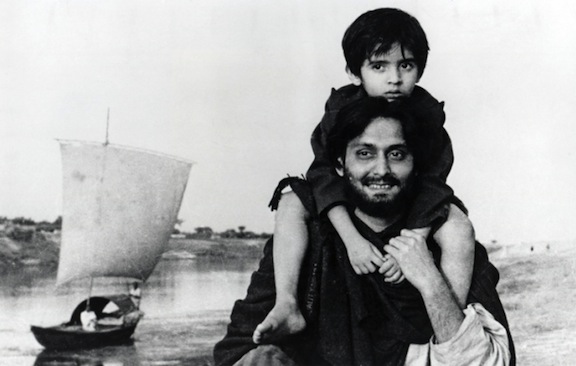
From “Apur Sansar”
The restoration is, as its producers justifiably state, itself an act of faith, and their efforts have garnered high praise. “Future restorations will be judged by this standard,” Jake Cole wrote in Slant: “Criterion’s restoration work is always worthy of praise, but in the case of Satyajit Ray’s films, they have been showcases for the company’s preservation efforts. As with prior Ray releases, these three films come to us from horribly dilapidated negatives, yet the Blu-rays look pristine, with stable blacks and whites, consistent detail, and healthy grain. Audio has also been salvaged from scratchy, pop-ridden tinniness, and Ravi Shankar’s scores in particular can now be fully appreciated for the depths to which they comment and contrast with the images.”
— Peter Monaghan
Previous Post: Ken Jacobs's Dissected Doctor’s Dream
Next Post: How to Celebrate 120 Years of Cinema



